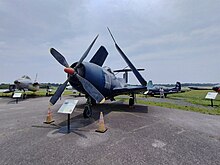Curtiss XF15C
| XF15C | |
|---|---|

| |
| Role | Fighter |
| National origin | United States |
| Manufacturer | Curtiss Aeroplane and Motor Company |
| First flight | 27 February 1945 |
| Number built | 3 |
The Curtiss XF15C-1 is a mixed-propulsion fighter prototype of the 1940s. It was among a number of similar designs ordered by the US Navy before pure-jet aircraft had demonstrated their ability to operate from carriers and the mixed-propulsion designs were abandoned. Only three prototypes were constructed, the first one having crashed in testing while the second was scrapped and the last survives to this day.
Development
[edit]By the late 1940s, the United States Navy was interested in the mixed-power concept for its shipborne fighters. Jet engines of that era had very slow throttle response, which presented a safety concern in the case of a missed approach on an aircraft carrier as the aircraft might not be able to throttle up quickly enough to keep flying after leaving the end of the deck. This led to orders for a number of mixed-propulsion fighters, including the FR Fireball.
As such, an order was placed with Curtiss on 7 April 1944 for delivery of three mixed-power aircraft, designated the F15C. Powered by both a 2,100 hp (1,566 kW) Pratt & Whitney R-2800 Double Wasp propeller engine, and an Allis-Chalmers J36 turbojet, the aircraft was in theory the fastest fighter in the US Navy at that time.
Operational history
[edit]The first flight of the first prototype was on 27 February 1945, without the turbojet installed. When this was completed in April of the same year, the aircraft flew several mixed-power trials, however on 8 May, it crashed on a landing approach. The second prototype flew for the first time on 9 July 1945, and was soon followed by a third prototype. Both aircraft showed promise. However, by October 1946, the Navy had lost interest in the mixed-power concept and cancelled further development.
Surviving aircraft
[edit]
- XF15C-1
- Of the two remaining prototypes, one was scrapped after the end of World War II,[citation needed] and the other remained in storage until it was released by the Navy for museum display. It was then located at the Bradley Air Museum, later renamed New England Air Museum in Windsor Locks, Connecticut at the Bradley International Airport. It was later relocated to the Quonset Air Museum in North Kingstown, Rhode Island.[1][2] A part of the roof collapsed because of ice and snow in March 2014, and this museum is now closed.[2] The sole survivor is now on static display at the Hickory Aviation Museum, in Hickory, North Carolina.[3]
Specifications
[edit]
Data from Jane's all the World's Aircraft 1947,[4] Curtiss aircraft 1907-1947[5]
General characteristics
- Crew: 1
- Length: 43 ft 8 in (13.32 m) tail up
- Wingspan: 48 ft (15 m)
- Width: 20 ft 5 in (6.22 m) wings folded
- Height: 15 ft 3 in (4.65 m) wings spread; 17 ft (5.2 m) wings folded
- Wing area: 400 sq ft (37 m2)
- Empty weight: 12,648 lb (5,737 kg)
- Gross weight: 16,630 lb (7,543 kg)
- Max takeoff weight: 18,698 lb (8,481 kg) maximum overload
- Powerplant: 1 × Pratt & Whitney R-2800-34W Double Wasp 18-cyl. air-cooled radial piston engine, 2,100 hp (1,600 kW)
- Powerplant: 1 × Allis-Chalmers J36 centrifugal flow turbojet, 2,700 lbf (12 kN) thrust
- Propellers: 4-bladed Hamilton Standard constant-speed fully feathering propeller, 13 ft 1 in (3.99 m) diameter
Performance
- Maximum speed: 469 mph (755 km/h, 408 kn) both engines at 25,300 ft (7,700 m)
- Range: 1,385 mi (2,229 km, 1,204 nmi)
- Service ceiling: 41,800 ft (12,700 m)
- Rate of climb: 5,020 ft/min (25.5 m/s)
Armament
- Guns: 4x wing-mounted 20 mm (.79 in) cannon
See also
[edit]Aircraft of comparable role, configuration, and era
References
[edit]- ^ Vladimir Yabukov. "Curtiss XF15C-1, Quonset Air Museum, North Kingstown, RI, by Vladimir Yakubov". svsm.org. Retrieved 10 August 2017.
- ^ a b "Quonset Air Museum". AviationMuseum. 9 October 2016. Retrieved 10 August 2017.
- ^ Bailey, John (16 May 2018). "Rare jet to debut at aviation museum". Hickory Daily Record. Retrieved 28 April 2019.
- ^ Bridgman, Leonard, ed. (1947). Jane's all the World's Aircraft 1947. London: Sampson Low, Marston & Co. pp. 211c – 212c.
- ^ Bowers, Peter M. (1979). Curtiss aircraft : 1907-1947. London: Putnam. pp. 506–508. ISBN 0370100298.
Bibliography
[edit]- Andrews, Hal (1977). "End of a Line... The Last Curtiss Navy Fighter". Air Enthusiast (3): 98–108. ISSN 0143-5450.
- Bedford, Alan (May–June 1999). "Earl American Carrier Jets: Evolving Jet Operations with the US Fleet, Part One". Air Enthusiast (81): 13–19. ISSN 0143-5450.
- Green, William; Gordon Swanborough. The Complete Book of Fighters. Godalming, UK: Salamander Books. pp. 143–144.
